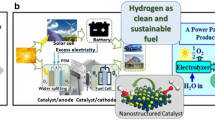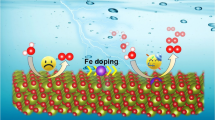Abstract
Enzymes from hyperthermophilic archaea are potential candidates for industrial use because of their superior pH, thermal, and long-term stability, and are expected to improve the long-term stability of biofuel cells (BFCs). However, the reported multicopper oxidase (MCO) from hyperthermophilic archaea has lower redox potential than MCOs from other organisms, which leads to a decrease in the cell voltage of BFCs. In this study, we attempted to positively shift the redox potential of the MCO from hyperthermophilic archaeon Pyrobaculum aerophilum (McoP). Mutations (M470L and M470F) were introduced into the axial ligand of the T1 copper atom of McoP, and the enzymatic chemistry and redox potentials were compared with that of the parent (M470). The redox potentials of M470L and M470F shifted positively by about 0.07 V compared with that of M470. In addition, the catalytic activity of the mutants towards 2,2′-azino-bis(3-ethylbenzothiazoline-6-sulphonic acid) (ABTS) increased 1.2–1.3-fold. The thermal stability of the mutants and the electrocatalytic performance for O2 reduction of M470F was slightly reduced compared with that of M470. This research provides useful enzymes for application as biocathode catalysts for high-voltage BFCs.




Similar content being viewed by others
References
Girouda, F., Sawada, K., Taya, M., & Cosnier, S. (2017). 5,5-Dithiobis(2-nitrobenzoic acid) pyrene derivative-carbon nanotube electrodes for NADH electrooxidation and oriented immobilization of multicopper oxidases for the development of glucose/O2 biofuel cells. Biosensors & Bioelectronics, 87, 957–963.
Palmore, G. T. R., Bertschy, H., Bergens, S. H., & Whitesides, G. M. (1998). A methanol/dioxygen biofuel cell that uses NAD+-dependent dehydrogenases as catalysts: application of an electro-enzymatic method to regenerate nicotinamide adenine dinucleotide at low overpotentials. Journal of Electroanalytical Chemistry, 443(1), 155–161.
Sakamoto, H., Komatsu, T., Yamasaki, K., Satomura, T., & Suye, S. (2017). Design of a multi-enzyme reaction on an electrode surface for an L-glutamate biofuel anode. Biotechnology Letters, 39(2), 235–240.
Ciniciatoa, G. P. M. K., Laua, C., Cochranea, A., Sibbettc, S. S., Gonzalezb, E. R., & Atanassov, P. (2012). Development of paper based electrodes: from air-breathing to paintable enzymatic cathodes. Electrochimica Acta, 82, 208–213.
Reid, R. C., Minteer, S. D., & Gale, B. K. (2015). Contact lens biofuel cell tested in a synthetic tear solution. Biosensors & Bioelectronics, 68, 142–148.
Sakuraba, H., Yokono, K., Yoneda, K., Watanabe, A., Asada, Y., Satomura, T., Yabutani, T., Motonaka, J., & Ohshima, T. (2010). Catalytic properties and crystal structure of quinoprotein aldose sugar dehydrogenase from hyperthermophilic archaeon Pyrobaculum aerophilum. Archives of Biochemistry and Biophysics, 502(2), 81–88.
Fernandes, A. T., Damas, J. M., Todorovic, S., Huber, R., Baratto, M. C., Pogni, R., Soares, C. M., & Martins, L. O. (2010). The multicopper oxidase from the archaeon Pyrobaculum aerophilum shows nitrous oxide reductase activity. The FEBS Journal, 277(15), 3176–3189.
Sakamoto, H., Uchii, T., Yamaguchi, K., Koto, A., Takamura, E., Satomura, T., Sakuraba, H., Ohshima, T., & Suye, S. (2015). Construction of a biocathode using the multicopper oxidase from the hyperthermophilic archaeon, Pyrobaculum aerophilum: towards a long-life biobattery. Biotechnology Letters, 37(7), 1399–1404.
Kamitaka, Y., Tsujimura, S., Setoyama, N., Kajino, T., & Kano, K. (2007). Fructose/dioxygen biofuel cell based on direct electron transfer-type bioelectrocatalysis. Physical Chemistry Chemical Physics, 9(15), 1793–1801.
Zebda, A., Gondran, C., Goff, A. L., Holzinger, M., Cinquin, P., & Cosnier, S. (2011). Mediatorless high-power glucose biofuel cells based on compressed carbon nanotube-enzyme electrodes. Nat. Commun, 2, ncomms1365.
Rasmussen, M., Abdellaoui, S., & Minteer, S. D. (2016). Enzymatic biofuel cells: 30 years of critical advancements. Biosensors & Bioelectronics, 76, 91–102.
Takamura, E., Nakamura, T., Sakamoto, H., Satomura, T., Sakuraba, H., Ohshima, T., & Suye, S. (2019). Effects of multicopper oxidase orientation in multi-walled carbon nanotube biocathodes on direct electron transfer. Biotechnology and Applied Biochemistry, 6, 137–141.
Reinhammar, B. M. (1972). Oxidation-reduction potentials of the electron acceptors in laccases and stellacyanin. Biochimica et Biophysica Acta, 275(2), 245–259.
Schneider, P., Caspersen, M. B., Mondorf, K., Halkier, T., Skov, L. K., Østergaard, P. R., Brown, K. M., Brown, S. H., & Xu, F. (1999). Characterization of a Coprinus cinereus laccase. Enzyme and Microbial Technology, 25(6), 502–508.
Rulíšek, L., & Ryde, U. (2013). Theoretical studies of the active-site structure, spectroscopic and thermodynamic properties, and reaction mechanism of multicopper oxidases. Coordination Chemistry Reviews, 257(2), 445–458.
Kataoka, K., Kogi, H., Tsujimura, S., & Sakurai, T. (2013). Modifications of laccase activities of copper efflux oxidase, CueO by synergistic mutations in the first and second coordination spheres of the type I copper center. Biochemical and Biophysical Research Communications, 431(3), 393–397.
Melo, E. P., Fernandes, A. T., Durao, P., & Martins, L. O. (2007). Insight into stability of CotA laccase from the spore coat of Bacillus subtilis. Biochemical Society Transactions, 35(6), 1579–1582.
Miura, Y., Tsujimura, S., Kurose, S., Kamitaka, Y., Kataoka, K., & Sakurai, T. (2009). Direct electrochemistry of CueO and its mutants at residues to and near type I cu for oxygen reducing biocathode. Fuel Cells, 9(1), 70–78.
Gunne, M., Höppner, A., Hagedoorn, P. L., & Urlacher, V. B. (2014). Structural and redox properties of the small laccase Ssl1 from Streptomyces sviceus. The FEBS Journal, 281(18), 4307–4318.
Mate, D. M., & Alcalde, M. (2015). Laccase engineering: from rational design to directed evolution. Biotechnology Advances, 33(1), 25–40.
Xu, F., Palmer, A. E., Yaver, D. S., Berka, R. M., Gambetta, G. A., Brown, S. H., & Solomon, E. I. (1999). Targeted mutations in a Trametes villosa laccase - axial perturbations of the T1 copper. The Journal of Biological Chemistry, 274(18), 12372–12375.
Amano, Y., Koto, A., Matsuzaki, S., Sakamoto, H., Satomura, T., & Suye, S. (2016). Construction of a biointerface on a carbon nanotube surface for efficient electron transfer. Materials Letters, 174, 184–187.
Kurose, S., Kataoka, K., Shinohara, N., Miura, Y., Tsutsumi, M., Tsujimura, S., Kano, K., & Sakurai, T. (2009). Modification of spectroscopic properties and catalytic activity of Escherichia coli CueO by mutations of methionine 510, the axial ligand to the type I Cu. Bull. Chem. Soc. Jpn., 82(4), 504–508.
Author information
Authors and Affiliations
Corresponding author
Ethics declarations
Conflict of Interest
The authors declare that they have no conflict of interest.
Ethical Statement
This article does not contain any studies with human participants or animals performed by any of the authors.
Additional information
Publisher’s Note
Springer Nature remains neutral with regard to jurisdictional claims in published maps and institutional affiliations.
Rights and permissions
About this article
Cite this article
Takamura, E., Taki, S., Sakamoto, H. et al. Site-Directed Mutagenesis of Multicopper Oxidase from Hyperthermophilic Archaea for High-Voltage Biofuel Cells. Appl Biochem Biotechnol 193, 492–501 (2021). https://doi.org/10.1007/s12010-020-03440-5
Received:
Accepted:
Published:
Issue Date:
DOI: https://doi.org/10.1007/s12010-020-03440-5




